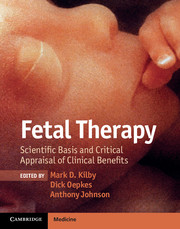Book contents
- Frontmatter
- Contents
- Contributors
- Foreword
- Preface
- Section 1 General principles
- Section 2 Fetal disease
- Chapter 6 Red cell alloimmunization
- Chapter 7 Fetal and neonatal alloimmune thrombocytopenia
- Chapter 8.1 Fetal dysrhythmias
- Chapter 8.2 Fetal dysrhythmias
- Chapter 9.1 Structural heart disease
- Chapter 9.2 Structural heart disease
- Chapter 9.3 Structural heart disease
- Chapter 10.1 Manipulation of amniotic fluid volume
- Chapter 10.2 Manipulation of amniotic fluid volume
- Chapter 11.1 Twin-to-twin transfusion syndrome
- Chapter 11.2 Twin-to-twin transfusion syndrome
- Chapter 11.3 Twin-to-twin transfusion syndrome
- Chapter 11.4 Twin-to-twin transfusion syndrome
- Chapter 11.5 Twin-to-twin transfusion syndrome
- Chapter 12.1 Twin reversed arterial perfusion (TRAP) sequence
- Chapter 12.2 Twin reversed arterial perfusion (TRAP) sequence
- Chapter 13.1 Fetal infections
- Chapter 13.2 Fetal infections
- Chapter 14.1 Fetal urinary tract obstruction
- Chapter 14.2 Fetal urinary tract obstruction
- Chapter 14.3 Fetal urinary tract obstruction
- Chapter 14.4 Fetal urinary tract obstruction
- 15.1 Fetal lung growth, development, and lung fluid
- Chapter 15.2 Fetal lung growth, development, and lung fluid
- Chapter 16.1 Neural tube defects
- Chapter 16.2 Neural tube defects
- Chapter 17.1 Fetal tumors
- Chapter 17.2 Fetal tumors
- Chapter 18.1 Intrauterine growth restriction
- Chapter 18.2 Intrauterine growth restriction
- Chapter 19.1 Congenital diaphragmatic hernia
- Chapter 19.2 Congenital diaphragmatic hernia
- Chapter 20.1 Fetal stem cell transplantation
- Chapter 20.2 Fetal stem cell transplantation
- Chapter 20.3 Fetal stem cell transplantation
- Chapter 21 Gene therapy
- Chapter 22 The future
- Glossary
- Index
- References
Chapter 18.2 - Intrauterine growth restriction
differential diagnosis and management
from Section 2 - Fetal disease
Published online by Cambridge University Press: 05 February 2013
- Frontmatter
- Contents
- Contributors
- Foreword
- Preface
- Section 1 General principles
- Section 2 Fetal disease
- Chapter 6 Red cell alloimmunization
- Chapter 7 Fetal and neonatal alloimmune thrombocytopenia
- Chapter 8.1 Fetal dysrhythmias
- Chapter 8.2 Fetal dysrhythmias
- Chapter 9.1 Structural heart disease
- Chapter 9.2 Structural heart disease
- Chapter 9.3 Structural heart disease
- Chapter 10.1 Manipulation of amniotic fluid volume
- Chapter 10.2 Manipulation of amniotic fluid volume
- Chapter 11.1 Twin-to-twin transfusion syndrome
- Chapter 11.2 Twin-to-twin transfusion syndrome
- Chapter 11.3 Twin-to-twin transfusion syndrome
- Chapter 11.4 Twin-to-twin transfusion syndrome
- Chapter 11.5 Twin-to-twin transfusion syndrome
- Chapter 12.1 Twin reversed arterial perfusion (TRAP) sequence
- Chapter 12.2 Twin reversed arterial perfusion (TRAP) sequence
- Chapter 13.1 Fetal infections
- Chapter 13.2 Fetal infections
- Chapter 14.1 Fetal urinary tract obstruction
- Chapter 14.2 Fetal urinary tract obstruction
- Chapter 14.3 Fetal urinary tract obstruction
- Chapter 14.4 Fetal urinary tract obstruction
- 15.1 Fetal lung growth, development, and lung fluid
- Chapter 15.2 Fetal lung growth, development, and lung fluid
- Chapter 16.1 Neural tube defects
- Chapter 16.2 Neural tube defects
- Chapter 17.1 Fetal tumors
- Chapter 17.2 Fetal tumors
- Chapter 18.1 Intrauterine growth restriction
- Chapter 18.2 Intrauterine growth restriction
- Chapter 19.1 Congenital diaphragmatic hernia
- Chapter 19.2 Congenital diaphragmatic hernia
- Chapter 20.1 Fetal stem cell transplantation
- Chapter 20.2 Fetal stem cell transplantation
- Chapter 20.3 Fetal stem cell transplantation
- Chapter 21 Gene therapy
- Chapter 22 The future
- Glossary
- Index
- References
Summary
Introduction
Intrauterine growth restriction (IUGR) is defined as failure of the fetus to achieve its biologically determined growth potential and is therefore likely due to an underlying pathological process [1]. The majority of cases of IUGR are discovered during the latter part of the third trimester and are caused by a degree of placental insufficiency and therefore generally have a good perinatal prognosis. However, a minority of cases of IUGR are diagnosed earlier as a result of severe placental insufficiency, or are due to some other cause and therefore require careful consideration of the likely diagnosis before a management plan can be developed.
To illustrate the potential difficulty in managing IUGR, a comprehensive differential diagnosis of maternal, fetal, placental, and genetic factors that may cause IUGR is summarized in Tables 18.2.1–18.2.4. The list expands with new knowledge, for example the recent demonstration of epigenetic dysregulation of specific genes in the placenta that may indirectly regulate fetal growth, such as WNT2 [9]. Identifying the underlying etiology of IUGR during the antepartum period is important both to reduce the rate of preventable perinatal losses, especially stillbirth of normally formed fetuses [10], and to avoid inappropriate delivery by Cesarean section for poor prognosis scenarios. Considerable advances in this area of perinatal medicine mean that increasing numbers of IUGR pregnancies are referred to maternal-fetal medicine centers for further assessment, such that increasingly accurate diagnoses are being made during the antenatal period; as such greater numbers of intact infants born with IUGR survive with careful intensive fetal monitoring, coordinated delivery, and optimal neonatal care [11].
Keywords
- Type
- Chapter
- Information
- Fetal TherapyScientific Basis and Critical Appraisal of Clinical Benefits, pp. 355 - 369Publisher: Cambridge University PressPrint publication year: 2012

